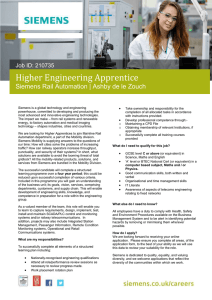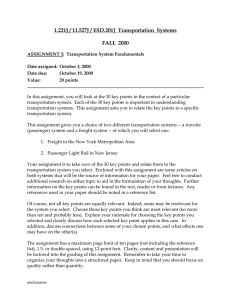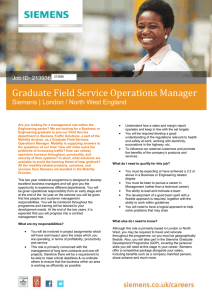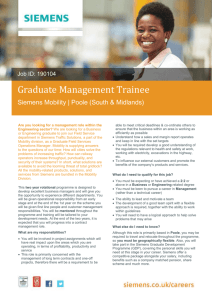Hubs of the future: An integrated mobility network for passengers
advertisement
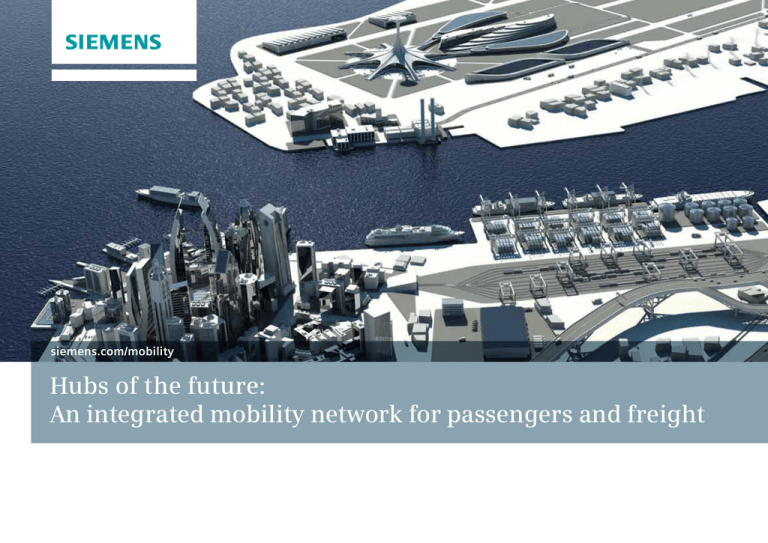
siemens.com/mobility Hubs of the future: An integrated mobility network for passengers and freight Seamless mobility for passengers and freight Hubs of the future06 Airports08 Stations10 Rail terminals 12 Ports14 Logistics centers16 Siemens answers20 Our world is rapidly changing. By 2050, 9.2 billion people will inhabit our planet. Cities are currently growing by two inhabitants per second. By 2030, more than 60 % of the population will be living in cities. At the same time, standards of living are rising, along with mobility and demand for consumer goods. These demands have created an enormous need for freight transport. In 2010, freight transport grew by 10 % worldwide, and most of that growth was concentrated in urban areas. The world’s transport infrastructure is under pressure and must be improved in order to handle the projected growth. As expert providers of complete solutions, we take advantage of technological synergies between the different types of hubs to provide fast, reliable, and sustainable mobility. We’d like to show you our vision of how we can overcome transportation challenges with leading-edge technology. As a pioneer, Siemens is always one step ahead – join us in discovering the future of integrated mobility. Transport hubs are extremely important because the increasing flow of passengers and goods has to be managed within and between urban centers. As nodes, hubs must intelligently network various transportation systems so that people and goods can be transported in a safe, efficient, and environmentally sound manner. Siemens has taken on the task of providing concrete answers to these challenges. Dr. Sami Atiya Huschke Diekmann CEO Mobility and Logistics Technology and Innovation 5 Siemens forges new paths to provide answers for the hubs of the future 3 1 Airports Each year, the number of airline passengers increases by 5 % to 6 %. Air freight traffic is growing at a comparable rate. Siemens provides solutions for safety and security, efficiency, and service that can help optimize airport processes to benefit both passengers and the environment. 2 Stations Integrated transport systems, shorter routes, added convenience by providing passengers with a space integrated in an urban environment that includes trade and industry, opportunities for employment, housing, and recreation – all these factors will shape the railway station of the future. At the same time, security and energy efficiency are also becoming more important. Integrated solutions from Siemens address these challenges, and more. 3 Rail terminals Containerization in freight transport is on the rise, bringing with it increased terminal automation. The fast, efficient transfer of freight is an essential part of intermodal transport. Siemens solutions for terminal and railway automation ensure a seamless, on-time workflow. 4 Ports Ports are import and export hubs, forming the link between sea and land. With Siemens technologies, maritime and inland ports can manage growing passenger and freight traffic without having to expand their capacities and while collaborating with inland terminals even more efficiently. 5 Logistics centers Welcome relief for traffic networks and citizens: consolidating and distributing the flow of goods can help prevent a further reduction in the average speed of city traffic. Siemens has experience with all the key technologies needed to equip and operate urban consolidation centers. 5 Sustaining mobility, designing networks: Challenges that move us Source: International Transport Forum calculations using MoMo version 2011 Index of world passenger mobility [pkm] Index of world freight mobility [tkm] 414 400 400 350 350 300 348 300 306 250 250 200 200 150 150 100 100 260 2050 2040 2030 [Year] 2020 2050 2040 2030 2020 2010 50 2000 50 6 Index of the global transport activity, 2000-2050 2010 European transport companies are predicting that public transportation will increase by as much as 45 % in some countries until 2030. Growth is inevitable, but most of the passenger volume in western industrialized countries must be handled by existing infrastructure. Because funds available for public passenger transportation are stagnating and even dropping. In many developing economies, public transportation infrastructure still needs to be created. Along with mobility requirements, the need for security is also growing. In recent decades, dangers to public safety and transported goods have both increased. These safety issues require sustainable solutions. 2000 Passenger transport: Greater mobility requires greater capacity Demographic and social change are transforming the demands placed on passenger transportation systems. As a result of increased urbanization, a predicted 60 % of the world’s population will live in cities by 2030. The steady increase in the number of people using public transpor­tation as well as the ongoing implementation and expansion of rail traffic solutions indicate a growing demand for mobility. The result: increased pressure on the environment and climate. [Year] Freight transport: Growing economy, growing volume In the world economy, goods are exchanged, production chains are broken down, and intermediate products are transported across national boundaries. Over the next few years, Asian countries will continue to demonstrate the highest growth. The effect: the volume of goods transported worldwide will more than double in the next 20 years. About 80 % of these goods will travel by sea. Cargo handled at India’s seaports alone will increase by more than 10 % annually. As a result, there will be a higher demand for capacities in ports and rail terminals, as well as a steadily growing burden on freight rail lines. In Germany, the tons/km of freight transported will increase by 50 % from 2009 to 2025. The air freight market is growing dramatically: according to industry projections, it will achieve an annual growth rate of around 6 % until 2030. Up to 2030, passenger traffic worldwide, including all means of transport, will be growing at an annual rate of 1.6 %. The demand for freight transport is expected to grow 2.5 % annually until 2030. As the use of containers and large ships increases, container handling in ports will grow an average of 9 % annually until 2015. The average speed of car traffic in major cities today is frequently less than 20 km/h and is expected to slow even further. 7 Boosting capacity: Airports of the future Increased mobility and worldwide population growth will result in more passengers at the airports of the future. Airplanes will increasingly serve as mass transit systems, and airlines will have to adapt their capacities accordingly. Customers will have the freedom to fly in and out of different airports. Efficiency, customer service, intermodal connections, and security will be their selection criteria. “Passenger delight has been one single goal for us at DIAL (Delhi International Airport Limited) [...]. The same will chart a course for us in the future as well. We wish to take some of the best ideas in the airport business and make them a reality for passengers at the New Delhi International Airport.” Growing efficiency Environmental concerns and process optimization are becoming more important factors in airport competitiveness. Many processes in airport buildings, aprons, and surroundings can be designed more efficiently. Integrated IT systems optimize workflows in terminals, in the air, and on the ground. Efficient technologies reduce energy consumption and increase throughput, so that airports can continue to grow within the boundaries of their existing infrastructure. Website of the Indira Gandhi International Airport, New Delhi, 2011 Greater convenience and security Security requirements will continue to grow. At the same time, there will be more focus on passenger convenience. That’s why in the future it will be necessary to ensure the required level of security almost without passengers even noticing. Transferring from one mode of transport to another will be easier. Travel information will be available via smartphone. The range of services available in and around airports will be expanded, resulting in an increasing number of sustainably planned and operated “airport cities”. 8 Game for the Games: More capacity for New Delhi Major events act as catalysts for the expansion of infrastructure, as demonstrated by the ultramodern, integrated Terminal 3 of the Indira Gandhi International Airport in New Delhi, completed in July 2010. In preparation for the XIX Commonwealth Games, capacities for passenger handling were expanded to 34 million passengers per year, making it the largest airport in India. According to the Airports Council International, worldwide passenger traffic at airports rose 6.6 % in 2010. This was the first time that the number of airline passengers exceeded five billion per year. Concern for the environment and energy efficiency are becoming increasingly important to airport operators. In 2011, the fourth Airports Going Green Conference was held in Chicago. The Airbus Global Market Forecast 2011 predicts worldwide demand for around 27,000 passenger planes with seating capacity for more than 100, and 900 new cargo planes until 2030. More than 30 % of this demand will come from the Asia-Pacific region. Terminal 3 has 168 check-in counters and 28 X-ray stations to screen all baggage checked. Siemens supplied the 13 km-long baggage handling system consisting of tilt-tray sorters, vertical sorters, and high-speed diverters. On the arrival level of the new terminal, 12 baggage claim systems provide trouble-free distribution of baggage to travelers. Siemens also electrified the Airport Metro Express Line and equipped it with state-of-the-art signaling technology, including a LZB automatic train control system and a Vicos OC operations control system. The high-speed line offers a safe, comfortable ride to and from the airport. Now passengers can also buy airline tickets and check their bags at the New Delhi and Shivaji Stadium metro stations. Before being automatically loaded onto the trains by the Sibag Train baggage handling system, the checked bags are run through an integrated X-ray system that can screen more than 12,400 pieces of luggage per hour. Bags are automatically unloaded at the airport and transferred to the baggage handling system. 9 Electrifying connection: Plug and Ride for Belgium Belgium’s passenger rail system has undergone a radical modernization. In addition to purchasing new vehicles, the National Railway Company of Belgium (SNCB-Holding) is overhauling the stations, too. The railway stations of the future are multimodal platforms that effectively integrate all carriers. SNCB Holding is now promoting “networked mobility”, which allows passengers to transfer to their transportation mode of choice at any time. In Gent, Liège, Brussels, and 31 other stations, SNCB-Holding is working with Siemens and the Belgian Ministry of Finance to expand the “Park and Ride” system to include “Plug and Ride”. To enable the use of electric cars, starting in 2011, the parking lots at these stations will be equipped with reserved parking stalls and e-charging stations. 10 More than 50 % of all train rides are combined with other modes of transportation at each end of the trip. By 2030, the percentage of people aged 65 and older will have nearly doubled from 7 % to 12 %, a trend that demands solutions to simplify traveling. Railway stations worldwide are being expanded and redesigned as integral components of urban life. Brussels, Bern, Vienna, San Francisco, and Riyadh, among others, are currently modernizing their train stations. Urban vitality: Stations of the future Passenger traffic is growing dramatically – especially in and between cities – causing increased demands for capacity, energy efficiency, and security in railway stations. Public transportation is appealing if it’s safe, comfortable, and reliable. Future railway stations will place more emphasis on meeting these requirements. Urban Integration The railway stations of tomorrow will offer multimodal transportation options and shorter routes. Additional comfort and convenience for passengers will be achieved by integrating stations into the urban environment, with links to trade and industry, and by providing employment, housing, and recreation opportunities. Public transportation and mobility options, including bicycle and electric car sharing, will exist side by side and be supplemented by intelligently linked information offerings and innovative services. Travel support systems Universal information and mobile payment systems will aid travelers in selecting modes of transportation, optimal rates, and alternative transport services in the event of delays. Travel system operators will be able to reach more passengers through selective dissemination of information and advertising. Secure infrastructure management The number of passengers using public transportation is growing. Innovative approaches are required to handle the increased flow of traffic using the existing infrastructure. Simu­ lations as well as intelligent information and management systems can aid infrastructure operators. Integrated security systems help operators prevent, detect, and respond to threats to passengers, assets, and business processes. „[...] Notre objectif est d‘être un acteur important de la mobilité durable. Le train et la voiture électrique sont complémentaires et, en les combinant, on peut donner un coup de fouet à cette mobilité durable.“ [...] Our goal is to be an important player in sustainable mobility. Trains and electric cars complement one another and, in combination, can give this sustainable mobility a boost. Vincent Bourlard, Directeur Général « Stations » of the Belgian National Railway SNCB/NMBS 11 Seamless availability: Rail terminals of the future „Die zunehmende Vernetzung von Schienenverkehren, aber auch die nachfragegerechte Versorgung von Zustellverkehren im Straßenvorund -nachlauf stellen an die Betriebsführung der Terminals hohe Anforderungen. Damit die vielen Räder erfolgreich ineinander greifen können, setzt die DUSS in ihren Terminals auf eine zielgerichtete Steuerung und Verarbeitung der transportbegleitenden Informationen, aus denen sich die Auftragsmanagementsysteme der verschiedenen Transportketten-Beteiligten speisen.“ The increased networking of rail traffic – but also the demand-driven supply of delivery services for collection and delivery by road – places more demands on terminal management. In order for the many gears to intermesh successfully, DUSS relies on targeted controlling and processing of the information accompanying transports within its terminals. The information from this system then feeds the order management systems of the various participants in the transport chain. Dipl.-Ing. Wolfgang Müller, CEO of Deutsche Umschlaggesellschaft Schiene-Strasse DUSS mbH 12 Freight is transported by rail whenever it offers a more reliable, safe, and efficient solution than road transport. Today, the quality of the logistics process is still compromised by gaps in the information chain. Nevertheless, the complex workflows in freight stations can be effectively improved through state-of-the-art technology. Optimized flow of goods At the rail terminal of the future, integrated terminal planning systems will provide logistical support for the flow of goods throughout the transportation chain. While automation systems will ensure efficient use of resources, automatic freight train monitoring systems will make rail transport even more reliable. Electronic seals and identification systems will also improve security to meet increased demand. Maximized continuity From rail to road, all the way to storage: soon, automated megahubs will take on a shape that offers many different transportation services bundled together. New technologies will be needed to guarantee the continuity of transport chains and information flows, as well as the seamless tracking of freight shipments. The development of rail terminals over the next few years will be shaped by containerization, increased intermodality, and the need to overcome infrastructure constraints. Until 2015, the intermodal terminals of the 30 largest European inland cargo facilities and seaports will have to increase their capacities by 40 %. The EU is attempting to create incentives for shifting 30 % of freight transport to railways and ships by 2030. Everything at a glance: Greater efficiency for Villach, Austria Villach South is Austria’s second-largest marshaling yard. The humping system at the main hump includes 12 reception tracks, 2 hump tracks, and 40 classification tracks. In 2009, Siemens modernized the operations control and terminal planning systems for ÖBB Infrastruktur Betrieb AG. Siemens installed the MSR32 automation system for train formation yards, the Vicos CM terminal planning system, and the new Arkos composition checking system. When integrated with Vicos CM, the MSR32 automation system makes it possible to predict workflows and detect scheduling conflicts before trains arrive. This predictability enables dispatchers to intervene in operational processes and resolve conflicts before they occur. The Arkos system ensures that the correct train composition enters and leaves the yard. With the new Siemens solution in place, up to 4,000 cars a day can be composed to form new trains in round-the-clock operations at Villach. 13 Traffic load relief and increased productivity: Traffic management and crane technology for ports worldwide Port operators in Long Beach and Los Angeles rely on a Siemens traffic information system. The system improves traffic management in the area surrounding the port by providing all participants in port traffic with real-time information about highway traffic conditions. Traffic flow sensors and systems that recognize license plate numbers record travel times and routes, while video cameras monitor access roads. Variable message signs in the areas around the two ports provide motorists, especially truck drivers, with up-to-the-minute alerts on unusual conditions ahead and – where available – estimated travel times. A website and email/text service keep trucking company dispatchers informed of all incidents in the coverage area. Transparency that can be felt: since the systems were installed in 2010, traffic density has been noticeably reduced in the areas around the two ports. The speed of freight movement within ports can also be increased. Many port operators rely on the latest crane technology from Siemens. Rotterdam, one of the world’s first automated terminals, and Dubai, the largest container port outside Asia, both use Siemens crane technology and benefit from continuously high productivity. The British Port of Felixstowe employs rubbertired gantry cranes (RTGs) equipped with fuelefficient, diesel-electric hybrid drives. The new generation of ECO RTGs from Siemens further boosts the energy efficiency of the drives. In addition, SIMOCRANE TPS, a system for automatically positioning trucks, has improved the precision of container handling in Felixstowe since it was installed in 2010. 14 The new giant vessels on the world’s oceans hold 18,000 TEU (twenty-foot equiva­­ lent units). Market leader Maersk has already ordered 10 of these ships – other companies will follow suit. Environmentally friendly behavior pays off: Rotterdam’s Green Award gives a discount on port fees to ships that demonstrate an especially high safety and environmental-protection standard. Fifteen of the world’s twenty leading container ports are in the Asian growth markets. Fluent networking: Ports of the future Seaports are essential logistics centers of the global economy because the main streams of international commerce flow through them. Efficient links to inland terminals are becoming more and more important. To handle the growing volume of freight in international maritime traffic, expanding these links is imperative. Challenging volumes Hamburg is already Europe’s largest railway port, processing more than 4,500 railcars daily. And the percentage of freight shipped by container will continue to grow. Container volume will steadily increase, especially in emerging markets, posing a tremendous challenge for ports of the future. Port operators must integrate port and inland services, use resources efficiently, and meet stricter security requirements. Sustainable solutions Efficiency and eco-friendliness: the ports and rail terminals of the future will achieve these goals through improved handling facilities, CO2-free transport systems, and comprehensive terminal management solutions. Using Siemens technology to supply onshore power to ships, CO2 emissions in ports can be reduced by up to 35 %, and NO2 emissions almost completely eliminated. „Der Hamburger Hafen liegt mitten in der Stadt. Insofern können wir nicht einfach Küstenflächen aufschütten, um neue Terminalflächen zu schaffen. Wir arbeiten also weiter daran, noch effizienter zu werden und nach innen zu wachsen.“ The Port of Hamburg is located in the middle of the city, so we can’t just add onto coastal areas to create new terminal space. Consequently, we’re continuing to work on becoming more efficient and growing internally. Wolfgang Hurtienne, Managing Director, Hamburg Port Authority 15 Concentrated agility: Logistics centers of the future Regulating city traffic was already a concern in ancient Rome. In the future, cities will struggle even more to manage increased traffic. The average speed of city traffic will drop below 20km/h, making on-time deliveries nearly impossible. In addition, legal restrictions on CO2 and NO2 emissions will be tighter. This is where city consolidation centers come in. „Quae viae in urbem Romam sunt erunt intra ea loca, ubi continenti habitabitur, ne quis in ieis vieis post kalendas Ianuarias primas plostrum interdiu post solem ortum, neve ante horam decimam diei ducito agito, ...“ After next January 1st, no one shall drive a wagon along the streets of Rome or along those streets in the suburbs where there is continuous housing after sunrise or before the tenth hour of the day. Gaius Iulius Caesar, Lex Iulia Municipalis, 45 BC 16 Bundled distribution Logistics centers will be able to support efficient, environmentally friendly goods distribution in large metropolitan areas and megacities. Consolidation centers are logistics centers that bring together flows of goods for an entire city or region. These flows will then be consolidated (bundled) and distributed throughout the city. Automated freight handling, along with flexible IT systems, will enable faster, customer-specific movement of goods. Bundled relief Different suppliers – some of whom are in competition with one another – will have to cooperate and ship their products together via a single shipper. A sensible consolidation will reduce transports, save money, and decrease the number of delivery vehicles in the city, along with the number of kilometers travelled. The result: a less congested inner city and residents who benefit from fewer vehicle emissions. At the London Heathrow Consolidation Centre, 700 incoming deliveries per week are consolidated into 300 outgoing deliveries, a significant reduction in airport traffic. “Last mile” deliveries in major cities are performed with an average load factor of only 50 %. The EU Commission is striving to reduce traffic-related CO2 emissions to about 20 % of the 2008 level by 2030. Vision 2020: Citiport AG supplies Berlin January 15, 2020. The people of Berlin can breathe easily. In the future, there will be much less delivery traffic to pollute Berlin’s air. In 2019, the Berlin Senate passed a law to reduce the traffic in the city’s center. Starting in January, only 5,000 delivery vehicles per day will be allowed in. In response, the local transport companies established Citiport AG. Its four consolidation centers on the margins of the regulated area have been making deliveries to the city center for the past week. Within the service area, there are “micro-depots” for the temporary storage of goods where customers can also pick up and drop off packages at any time of day or night. The “Berlin Consolidation Centers” (BCC) are located near the expressway. Each has a rail link, and one is even right next to the port. Each of the centers serves two to three districts, at 6:00 a.m., 10:00 a.m., 3:00 p.m., and 6:00 p.m., respectively. Only one vehicle drives into each street. Citiport AG uses trucks with both refrigerated and unrefrigerated compartments, e-tricycles, electric vans, and even boats. Route planning for the BCC fleet is dynamically optimized using data from the traffic management center. Time-critical deliveries are immediately dispatched by Citi-Express, which uses only electric vehicles. 25 % of the Citiport AG fleet is already made up of electric vehicles. The Senate’s objective for 2030 is for all trucks under 7.5 tons to be operated electrically and for heavier trucks to run on biogas. This will reduce the traffic in the city center so significantly that noise and exhaust fumes will soon be things of the past. 17 The time to forge 18 new paths is now. 19 Solutions for airports Know-how for ports · Airport management systems · Port management systems · Passenger and baggage handling · Terminal and gate automation · Passenger information systems · Baggage and freight transportation and sorting systems · Identification of baggage and freight · Fuelling systems · Crane solutions · External power supply for ships · Container security solutions · Tank terminal solutions · Passenger and baggage handling Expertise for logistics centers ·Receiving / unloading automation ·Identification solutions ·Sorting, ware-housing, buffering and order picking solutions Answers for rail terminals ·Dock and yard management · Operation and disposition systems ·“Last mile” IT solutions · Container handling · Terminal and gate automation · Identification of goods and containers · Crane solutions · Automatic number plate recognition · Intermodal logistics Solutions for stations · Passenger information systems · Intermodal connections · City check-in · Baggage handling · Booking and ticketing solutions 20 Because the world of tomorrow needs our answers today.* Intermodal solutions ·High speed and commuter trains · Road traffic control and management ·Trams, metros, people mover ·Electromobility ·Rail automation · Parking solutions ·Rail infrastructure Building and energy management, lighting Utility solutions Safety and security Value added services IT and operations · Building management · Building automation · Lighting products and light management systems · Low voltage solutions · Building performance contracting · Energy distribution and management · Smart grid · Energy generation · Water and wastewater · Fire safety systems · Access control and video management · Evacuation systems · Danger management · Command and control systems · Security integration · Green and efficient hubs · Operation and maintenance · Intermodal consulting · Turnkey projects · Planning and simulation · Inventory and asset management · Terminal operating systems · Control rooms · IT infrastructure · Network management · Communication solutions · Remote services · Rail communication * The products and services listed here form only a part of the comprehensive Siemens portfolio. Photo credits: p. 11 Copyright SNCB-Holding All other photos: Siemens AG Vicos®, Arkos®, MSR32®, Sibag®, ECO-RTG®, and SIMOCRANE® are registered trademarks of Siemens AG. The information in this document contains general descriptions of technical options available, which do not always have to be present in individual cases. The required features should therefore be specified in each individual case at the time of closing the contract. Siemens AG Infrastructure & Cities Sector Mobility and Logistics Division 80200 Munich Germany contact.mobility@siemens.com www.siemens.com/mobility © Siemens AG 2011 Printed in Germany HL 11076173 172234 WS 10112.0 Dispo 21700 c4bs 7607 Order no.: A19100-V901-B116-X-7600
